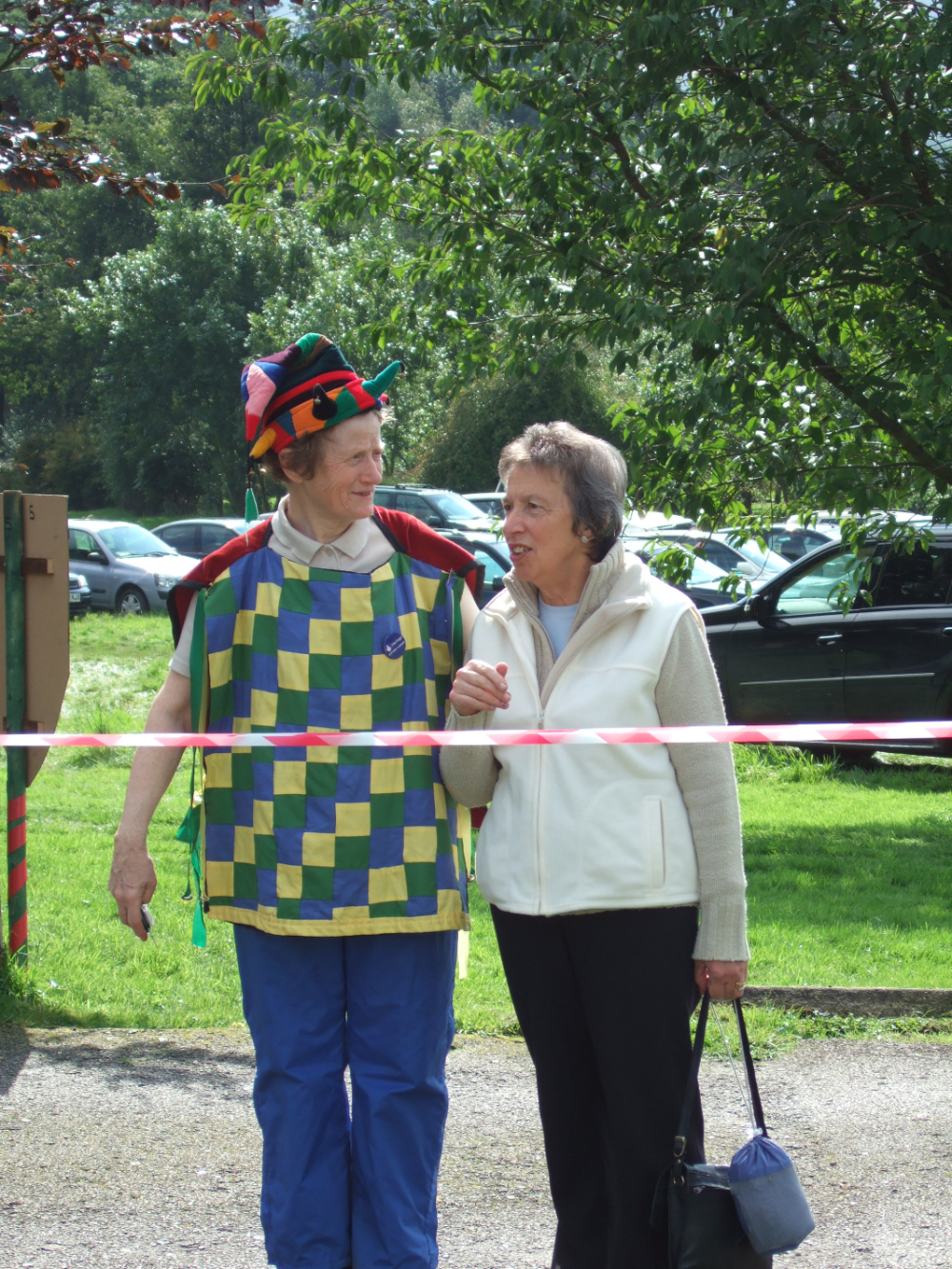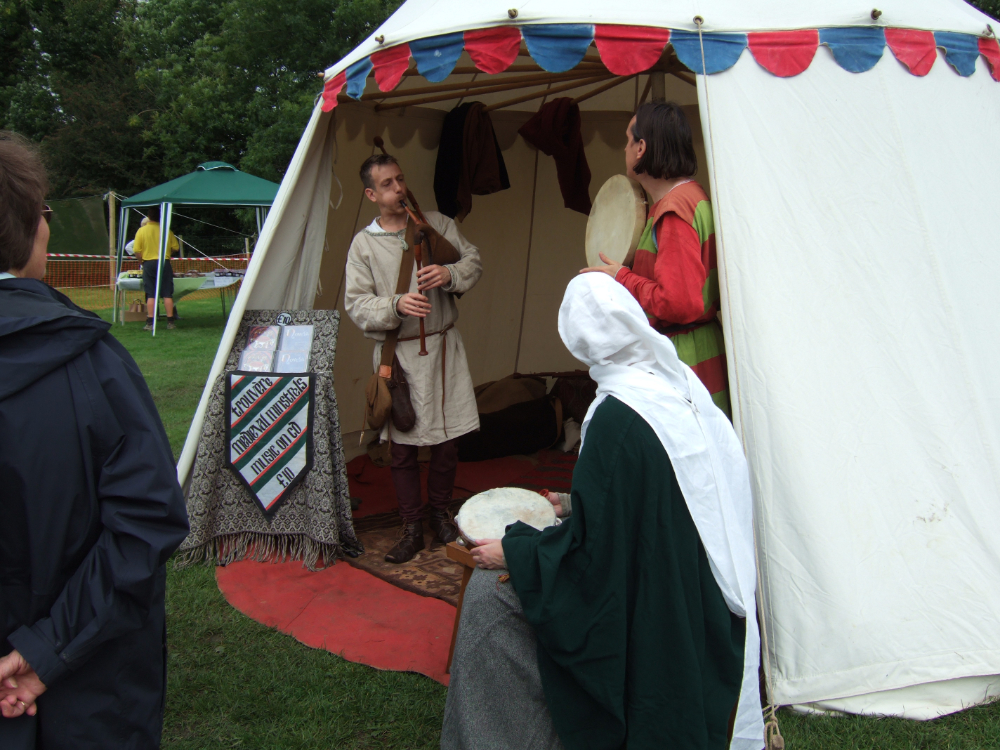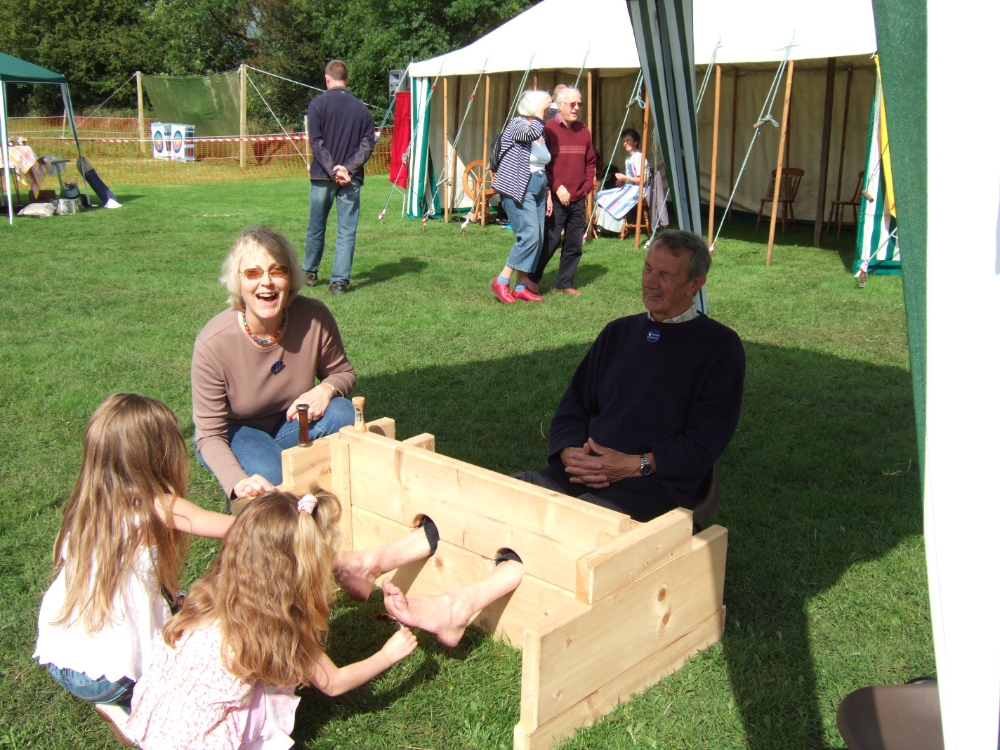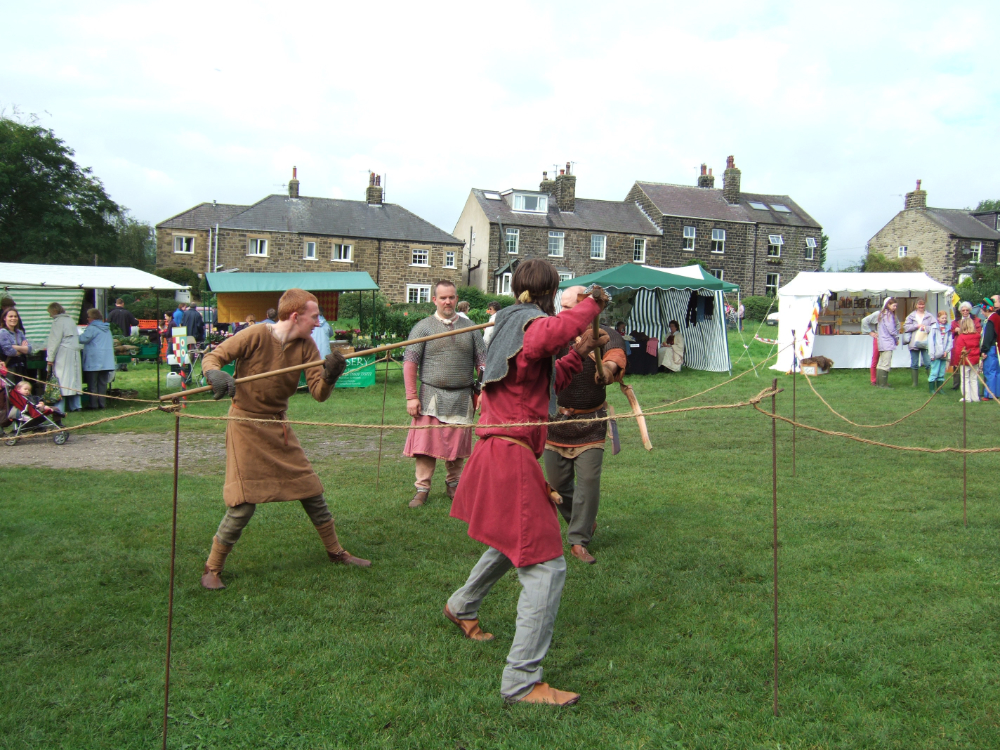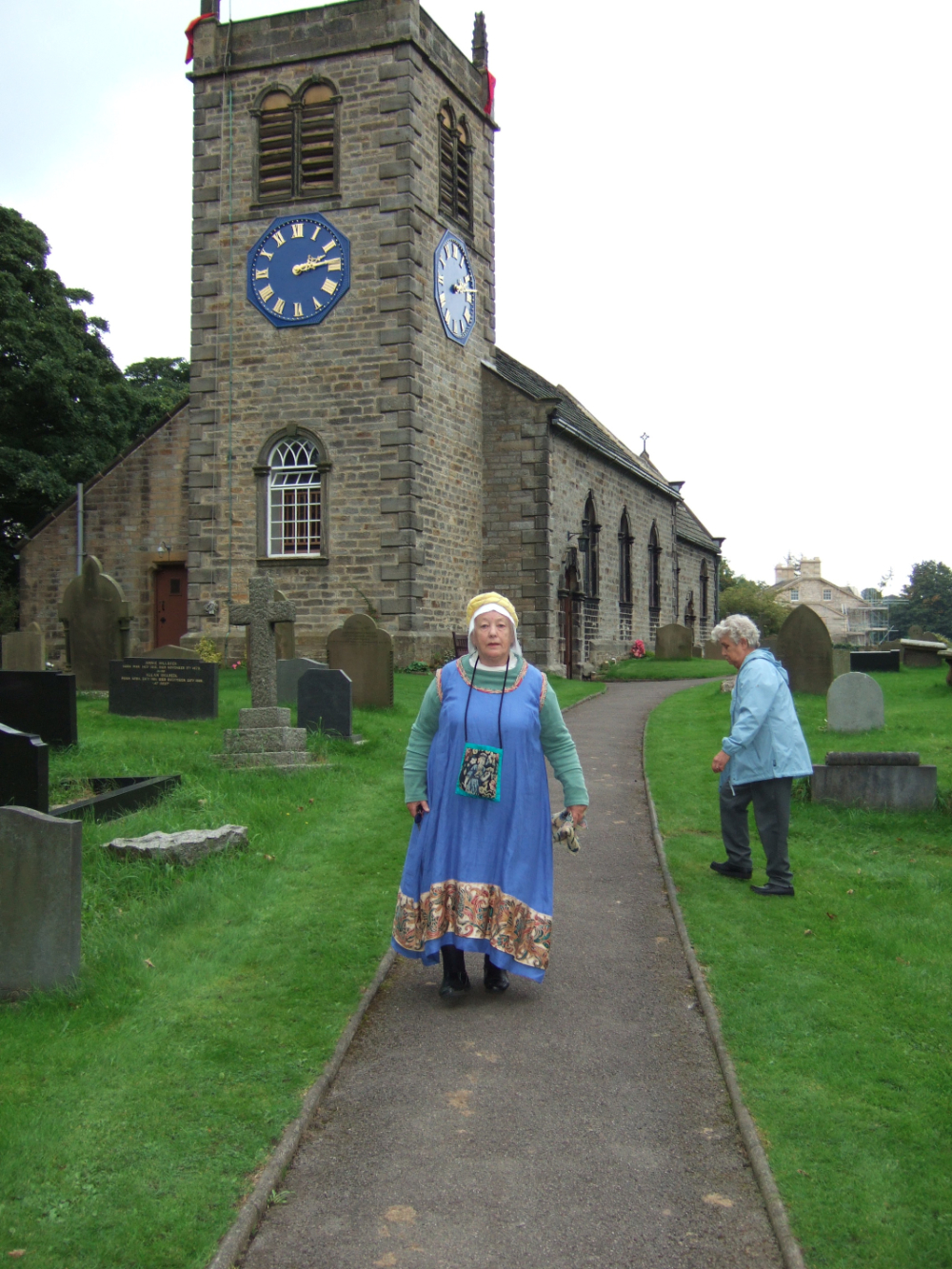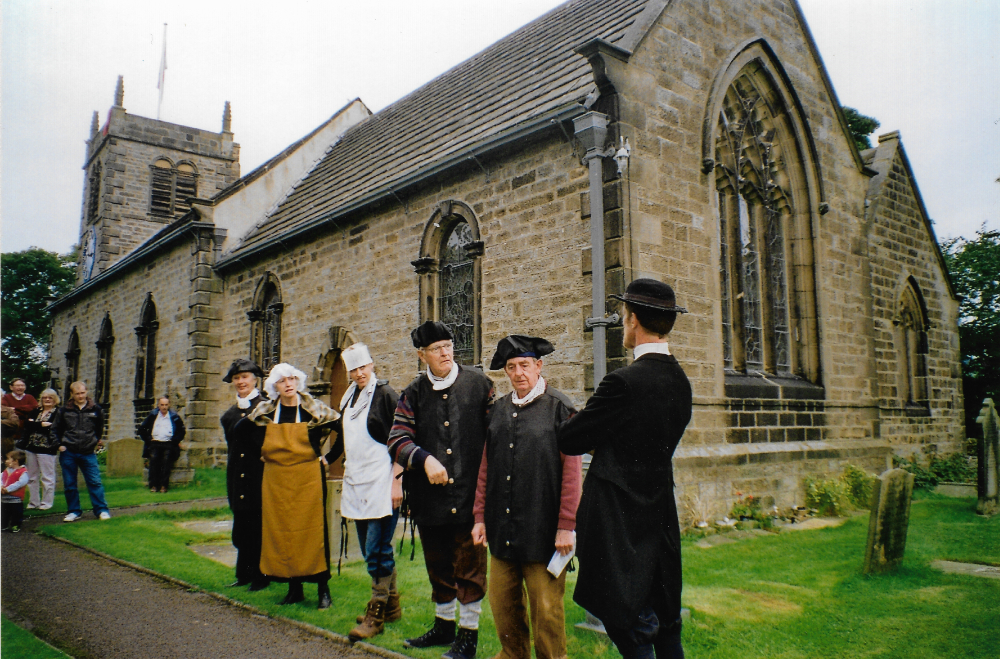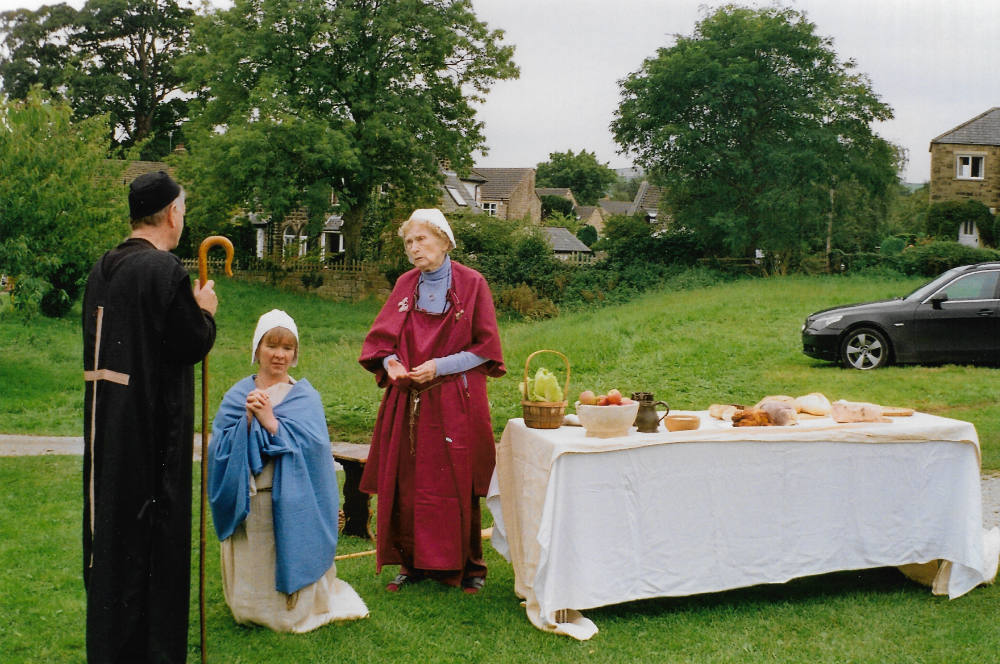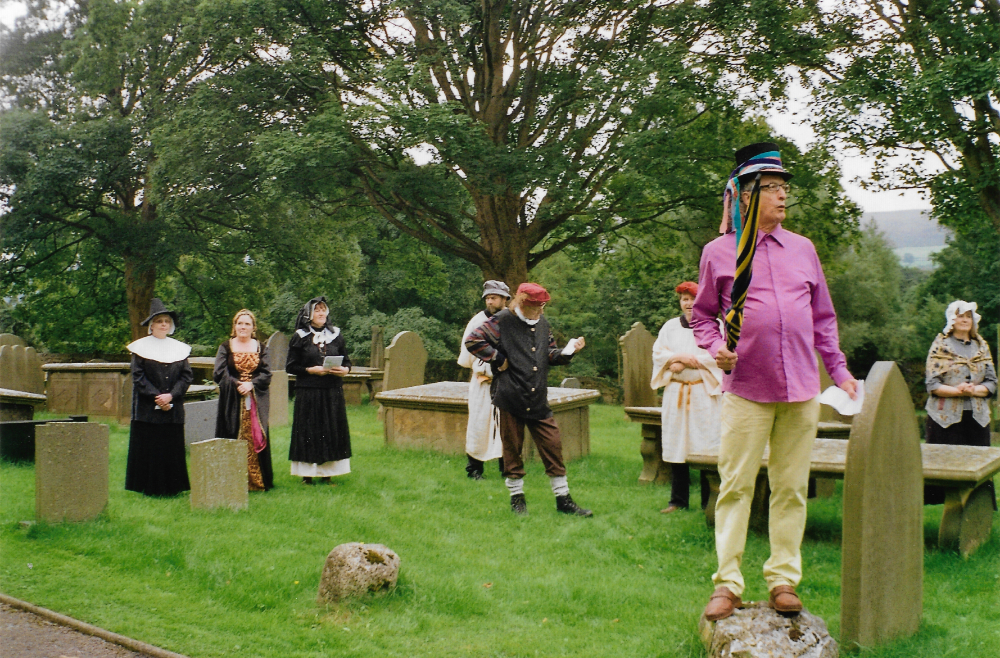A project celebrating Addingham’s Christian timeline
A multi-facetted project to celebrate the history of St Peter’s Church and its surroundingsIntroduction
St Peter’s stands in a lovely setting, in a field surrounded by a picturesque and much-loved churchyard; in Spring there is a succession of snowdrops, cherry blossom and thousands of daffodils. People come from far and wide to see this beauty and to find peace and a welcome in the church and its surroundings. Many do no not know of the unique and fascinating history of this site, of how Christianity has played its part here from the earliest years, and of how this has interacted with the development of the village of Addingham and the surrounding area.
St Peter’s is the site of an Anglian-age cross. Other crosses may be seen in parish churches at Ilkley, Otley and Leeds. Archaeological digs here have shown that Saxon burials in St Peter’s grounds were more extensive than we had previously realised.
St Peter’s has massive roof timbers, and a detailed study has shown that these are like those used in the sixteenth century Great Barn at nearby Bolton Abbey.
Addingham is a close-knit village, and the Christian Time-Line extends beyond St Peter’s site to encompass the Methodist Church on Chapel Lane, Mt. Hermon Chapel on Main Street, and the Catholic Church of Our Lady and Christian Martyrs which faces historic Manor Garth, as well as other historic sites around the village.
It was the knowledge of this rich heritage which encouraged us in our plans for a project to explore and celebrate the timeline of Christianity in Addingham. The programme encompassed a range of complementary and interlinked “living history” activities and events over two years. Other village churches, the school, Addingham Civic Society, Olicana Historical Society and local businesses participated in the project, and interested individuals of all ages were fully involved, mainly as volunteers.
Archeological Dig at St Peter’s
During 1947 the shaft of an Anglian stone cross was discovered in the churchyard. Small scale digs between 1971 and 1976 found a viking bone fragment, possibly a comb case. (This can be seen inside the church).
In the 1990s we commissioned two further archaeological explorations from the West Yorkshire Archaeological Service. These were sited to the east and south of the Church Hall before extending the building.
Over eighty graves of our Saxon-age ancestors were discovered.
In October 2007 there was a third dig to facilitate a further extension to the hall. Funding for this third dig was provided by The Heritage Lottery Grant.
“It was a bright, sunny but wild October morning. Rain had made the site of the dig very muddy. Initial investigations had revealed little of significance, however late on the Monday afternoon skeletal remains were discovered. The archaeologists were keen to remove as much as possible for study, possible dating and other analysis – slowly and painstakingly this was carried out. A quiet group of people observed the work in silence, in looking into the ground all had bowed heads which was somehow in keeping with the occasion.” (comments from onlookers at the time)

The burials were commemorated by the gift of a tapestry and a reflective poem.
What appear to be two Saxon post holes were also excavated.
References:
- St Peter’s Church, Addingham, West Yorkshire Landscape Survey. ( 3 June – 15 July 1993) W. Y. Arch. Service for English Heritage
- Adams, M., 1996, “Excavation of a Pre-Conquest Cemetery at Addingham, West Yorkshire” Medieval Archaeology, 40, 151-191.
- St Peter’s Church Hall, Addingham, W. Yorkshire Archaeological Excavation and Watching Brief April 2008Report No. 1942 (W.Y. Arch. Services.)
Dendro-dating St Peter’s Church Roof Timbers
Dr Ian Tyers of the Dendrochronology Laboratory in the Department of Archaeological Science at the University of Sheffield worked at the church for two days in October 2006. Working from a scaffolding and on a ladder, he took 14 different samples from within the church roof timbers in the North Aisle and the Nave, using a special drill.
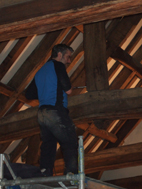
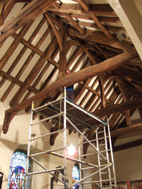
An observer of the process writes, “The wood was so hard that the drill heated up as it cut into the beams, so filling the church (temporarily!) with the smell of bonfires.”
Watching Dr Tyers were Arnold Pacey, a well-known local historian, and Alison Armstrong, formerly of Addingham who has herself undertaken amateur dendrochronology.
The dendrochronological dating analysis results are available in the report, Tree-ring analysis of timbers from a building: St Peter’s church, Addingham, West Yorkshire (February 2007). The earliest date was found to be from a tie-beam sample in the Nave, from which a likely felling period of AD1476-1512 was calculated. Dr Tyers writes in his report:
“The shrinkage and seasoning distortions on the original inner face of this tie beam suggests that this timber was sawn in half lengthwise whilst it was still relatively fresh and thus probably within a few months of its felling. In all likelihood therefore this timber was first used during either the late 15th or early 16th centuries.”
The results from the North Aisle samples suggest a felling period of between AD1511 and AD1531.
This is but a taster of the wealth of detail in the report which offers intriguing questions for our interpretation concerning the dating of the building with this wonderful roof. The report says:
“Overall the Addingham samples have produced a rather complex series of interpretive possibilities.”
Comparisons can be make between this testing and similar tests carried out on the roof of the Great Barn at Bolton Abbey.
We thank the Olicana Historical Society and Addingham Civic Society who contributed to the funding of the roof investigation, and Dr Tyers and his team for their work on the St Peter’s Heritage project.
An illustrated leaflet about the roof timbers was produced by the Civic Society and copies given to the church for sale. These are available at the back of the church.
Norman stonework at St Peter’s
In early October 2013, the pulpit and pews in the south-east corner of the nave at St Peter’s were moved to allow joists and floor boards to be replaced and an attack of dry rot to be dealt with. This briefly exposed an area of earth floor and a small part of the footings of the south wall.
It is known from documentary records that the south wall was rebuilt in 1756-7, and a survey of the church made by the stone mason Robert Carr before rebuilding began shows that the original south wall was considerably thicker than what replaced it. The footings exposed in 2013 suggest that the wall was rebuilt directly on the old foundations with the inner face of the wall set forward about 25-30 cm from the inner face of the foundation.
This left a wide ledge supporting an additional course of roughly squared stones with gaps between them into which joists were fitted. The existing pews stand on the floor supported by these joists, but there is also evidence of earlier box pews. At the ends of the pews next to the central aisle, which is paved with flags below the carpet, there are stone supports for the other ends of the joists. The lower end of an oak post which was part of the box pews is leaded into the stonework, and there are iron straps linking some stones.
The south wall is 69 cm thick above the exterior plinth and about 85 cm below it. Given that the foundations are 25-30 cm wider than this, they must be at least 110 cm wide in total.
Comparison can be made with the west wall of the nave where the tower built in 1757 butts against it. This wall was examined when the floor inside the tower was taken up in the 1980s. The west wall was not rebuilt when the tower was erected, but it shows signs of some alteration during earlier works when the north aisle was added to the church in the 1520s. The chamfered top course of the plinth seems similar to that of the aisle.
In other respects, though, the west wall is still substantially the wall of the first stone building on the site, probably dating from c.1155.
During the 1980s repairs, the thickness of the west wall was found to be 90 cm above the plinth and 102 cm thick below it, with footings about 113 cm wide. Tooling could be seen on some of the dressed stone, and this was typical of Norman axe-dressed masonry.
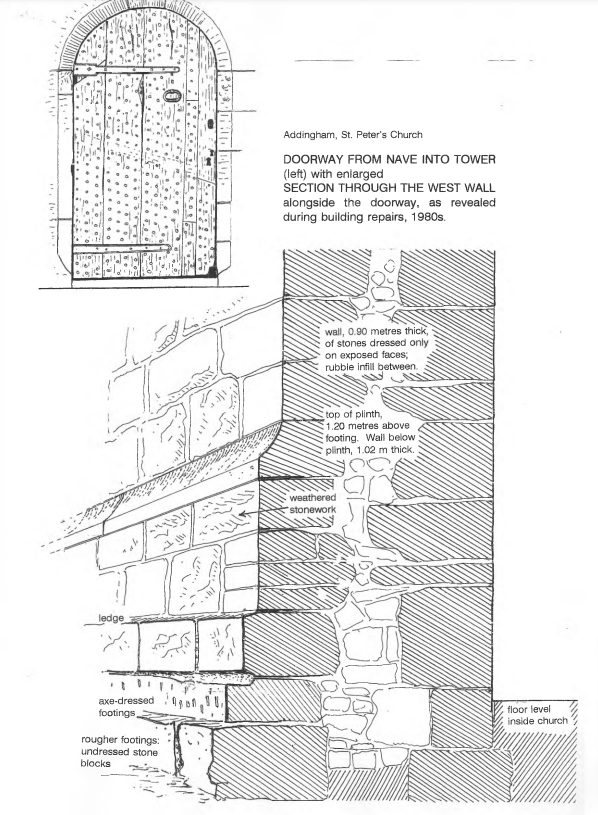
Section through the West wall
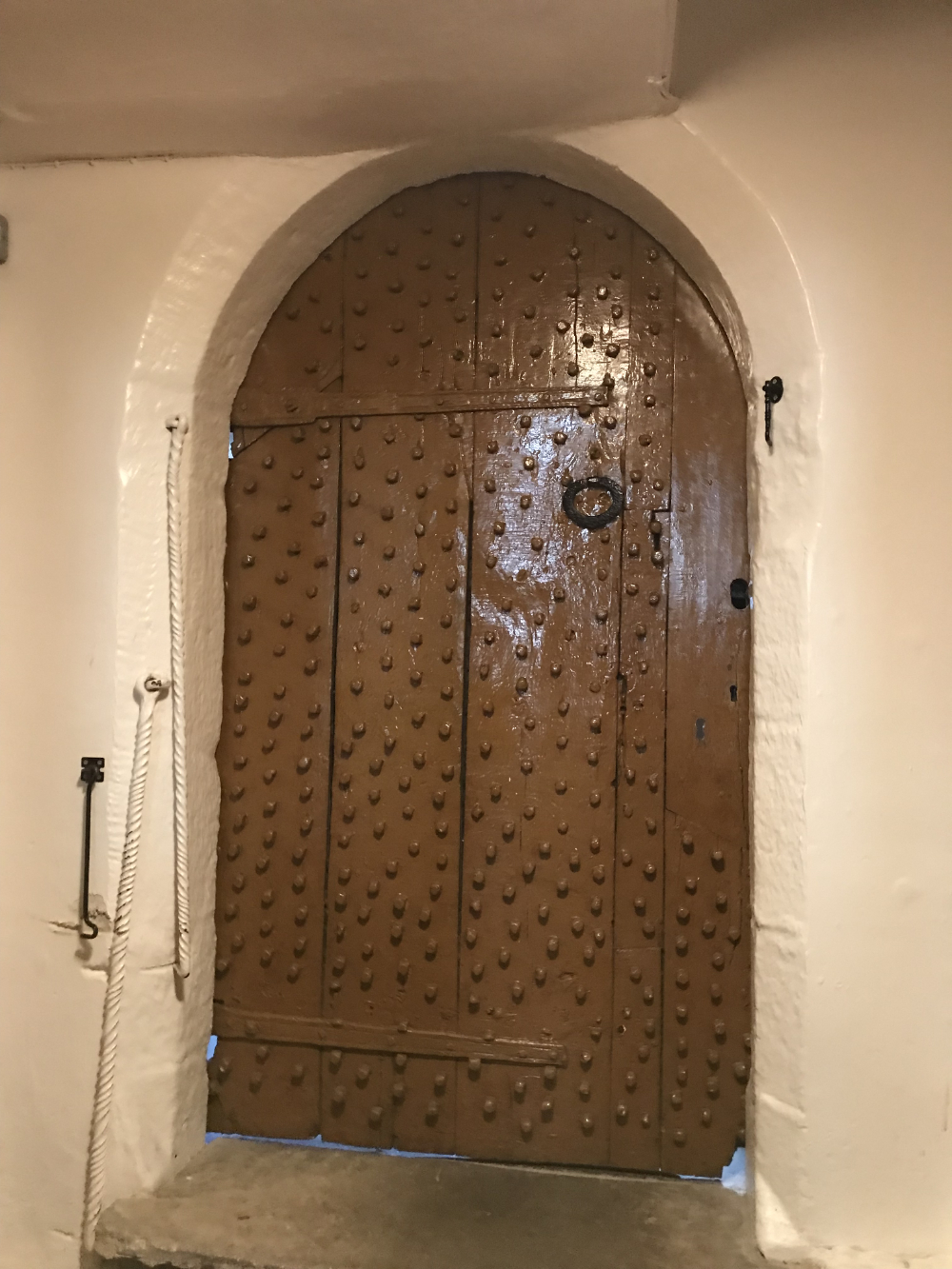
Tower door
The rather small part of the footings of the south wall exposed in October, 2013, appeared roughly built, without much dressed stone, and no tooling was seen. But the overall width of the footings of the south wall (over 110 cm) seems to be about the same as the footings of the west wall (c.113 cm). This tends to support the view that the eighteenth-century south wall of the church was built directly on top of the original, Norman foundations of c.1155.
The walls of Norman churches were often unusually thick by comparison with both earlier and later buildings. This was not for reasons of strength but because thick walls with wide reveals at doorways and window openings were felt to look impressive. The famous Norman church at Adel near Leeds was built about the same time as the original stone building at Addingham and has walls a little thicker than the west wall at Addingham.
These recent observations of the south wall suggest that all the walls of the Norman building at Addingham were of this thickness.
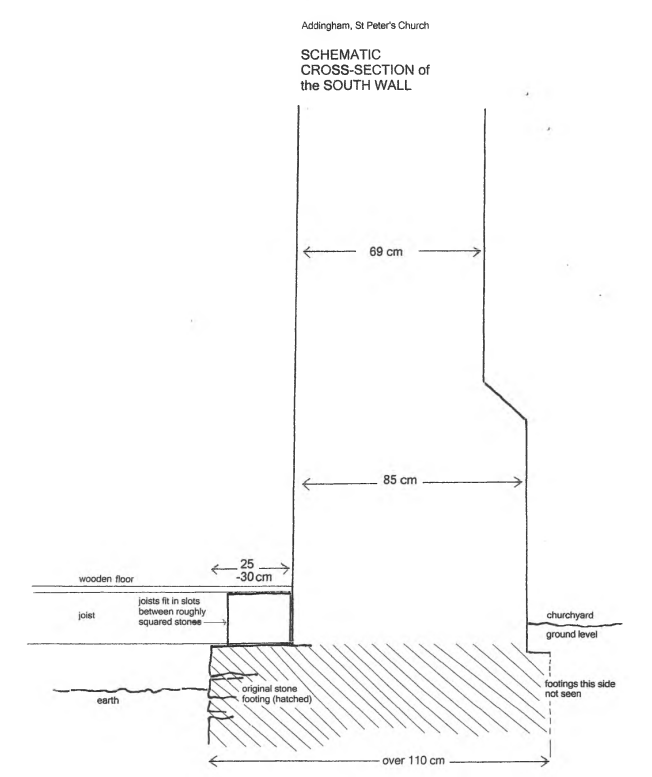
Cross-section of the South wall
Commemorative Stone Carvings
The artist and stone carver Fiona Bowley was commissioned to produce a representation in stone reflecting and celebrating the timeline of Christianity in Addingham, and to commemorate the burial site of our Anglo Saxon ancestors.
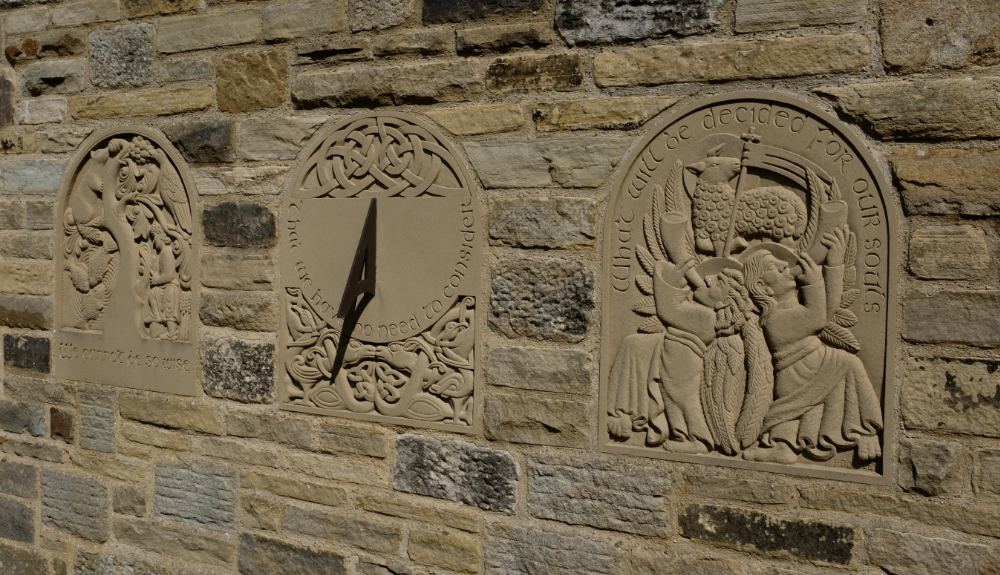
The three carved panels were dedicated by the Bishop during the Celebration weekend. They are very beautiful and are inscribed with following modern translation of St. Bede’s death song:
We cannot be so wise
That we have no need to consider
What will be decided for our souls
Fiona writes:
The three panels carry lines from the writings of the monk and scholar, Venerable Bede (673-739AD). The carvings reflect the Christian lives and beliefs of those who lived in Addingham in the 7th and 8th centuries. The central sundial reflects the passage of time.
Panel 1 . WE CANNOT BE SO WISE
The land is cultivated, cereals are grown for bread and vines for wine, mirror carp are farmed in ponds for food. The bird, the pine marten and the tree represent nature. While these are images of everyday life many of them are also symbols which carry religious significance.
Panel 2 THAT WE HAVE NO NEED TO CONSIDER
The shadow thrown by the gnomon travels across the stone and with its movement we see time passing as our ancestors did.
The interwoven monsters represent our fears and the knotwork gives us an opportunity to pause and to contemplate. Fear and the need to contemplate are also shared with those who lived here before us.
Panel 3. WHAT WILL BE DECIDED FOR OUR SOULS
This panel shows the Lamb of God, Christ triumphant. The angels trumpet the Last Judgement and proclaim the hope of Resurrection.
There is also a standing stone, reminiscent of a Saxon standing cross, in a stone bracket, surrounded by carved slabs, on the theme of the Celtic blessing “Deep peace of the running wave to you”, and a carved stone beneath the hall window, together reflecting the continuing timeline of Christianity in Addingham from Anglo Saxon times to today, the beauty of the setting of St Peter’s, and the message that God freely offers to us all every day the “deep peace of the Son of Peace”.
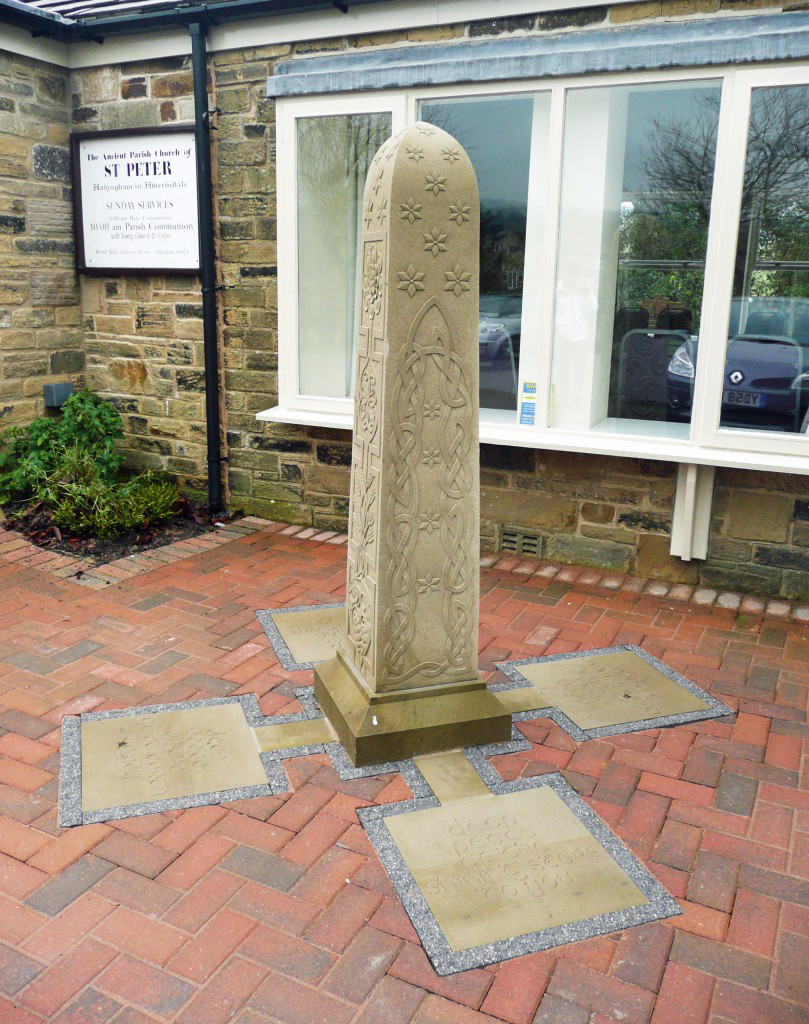
Standing stone
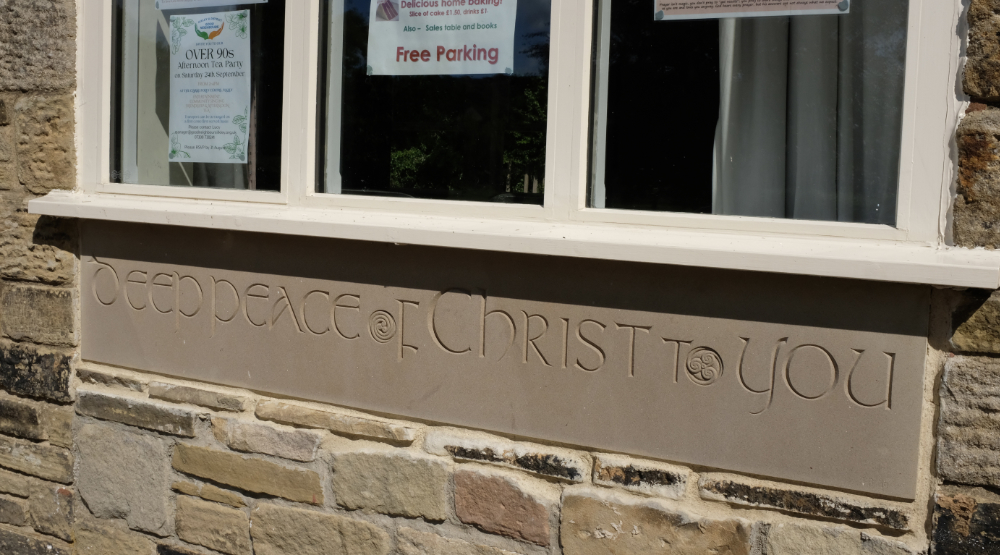
Peace stone
Project Workshops
Stone carving workshops
On 21st April 2007 – a most informative and enjoyable practical workshop on stone carving led by the artist and stone carver Fiona Bowley.
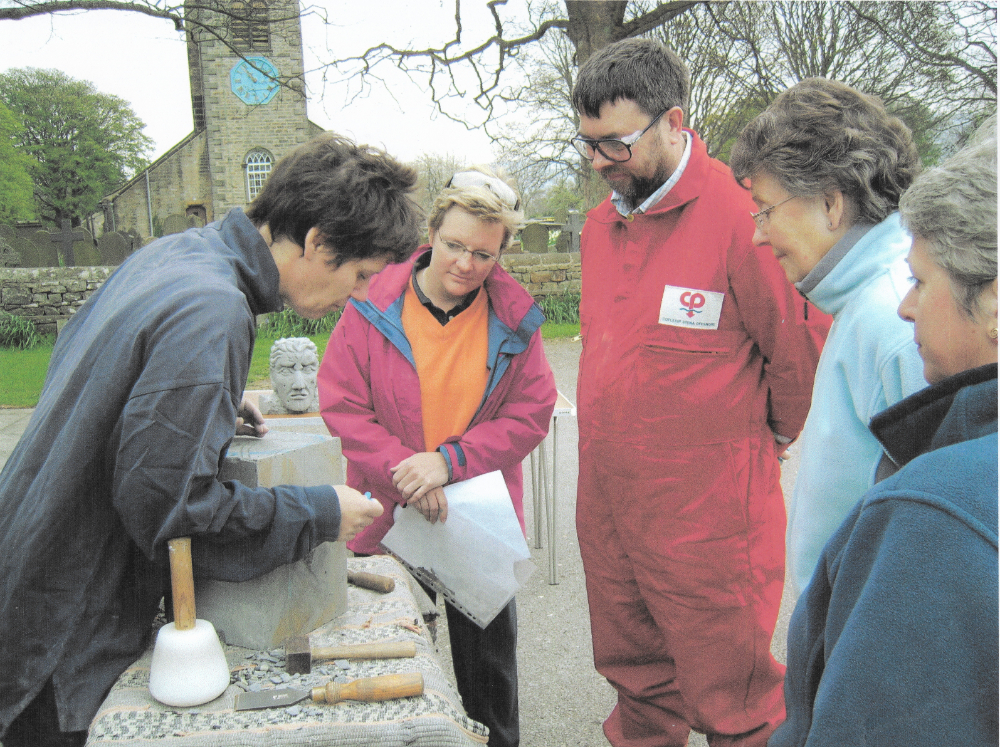
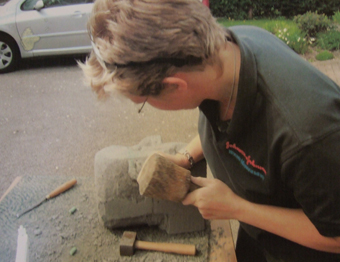
Fiona held a further two more stone carving workshops especially for children, on Thursdays 20th and 27th September 2007.
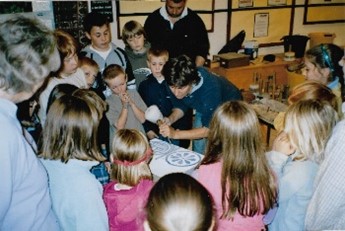
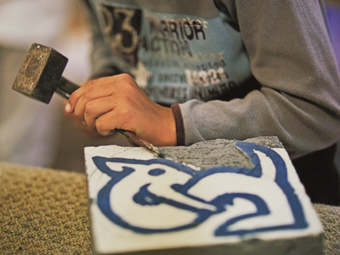
Anglo Saxon Spirituality
This event explored aspects of life in an Anglo Saxon village, including housing, work, clothing and jewellery, and the Christian spirituality of the people living at that time.
Can you recognise any words in this Anglo Saxon writing and work out what familiar spiritual text it is? (To help you, the letter that looks like a p but with a taller stalk is pronounced “th”, and the symbol like a backwards r means “and”)
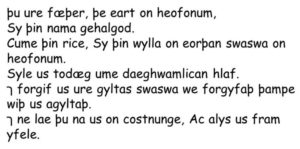
Village History Trail workshops
Two workshops were led by Catherine Snape of the Civic Society to compile a Village History Trail Leaflet. The first took place on Saturday 24th Feb 2007. The purpose was to plan the production and publication of a trail to highlight the location of Christian sites of our village.
The Inauguration of the Village Trail for the Christian Time Line was on Sunday 8th July 2007. A leaflet called Discovering Addingham’s Churches was designed produced. It is available from all village churches, the library, the Post Office and other venues. It incorporates all existing Church buildings and buildings with church or chapel links in the past, with maps of the route for a walk around the village.
Late Saxon and Mediaeval Art workshops : Illuminating the Word
A series of four workshops, led by Derek Law, following the Golden Thread from the establishment of the monastic system to the arrival of the printed word. We are very fortunate to have in the village such a wealth of knowledge and people who are willing to pass on their skills to others. Derek’s in-depth knowledge and breadth of experience were appreciated by all who attended the workshops.
Session 1 was on November 3rd, and covered the establishment of the Monastic Scriptorium tradition, the background to the production and use of Bibles and other Christian works. It explored the use made of finished bibles and how the evolution of modern learning has descended from this huge collection of manuscripts. The workshop involved practical explorations of the production of a manuscript Bible, including practical experiments with letterforms, feathers, eggs, calfskins and hand ground inks.
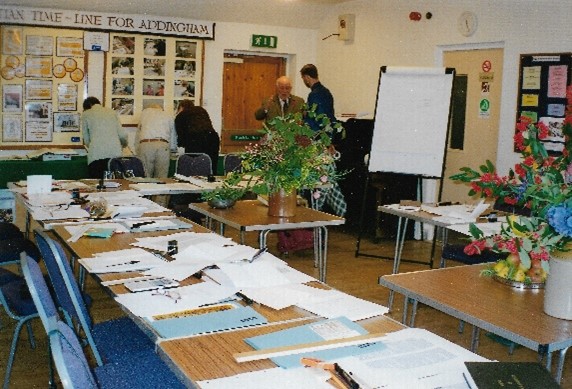
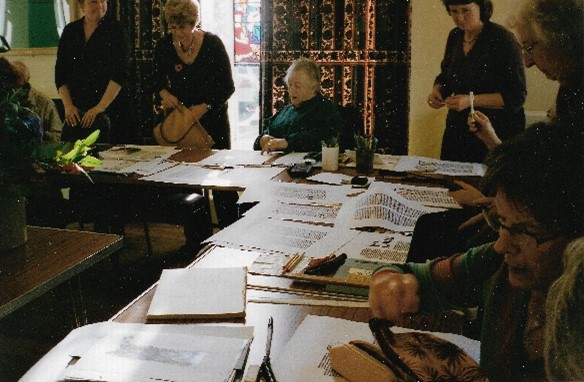
Session 2 was held on Saturday 23rd February 2008, a workshop on Printing, the Church and the Mind of Man 1400-1560. We were brought forward from the time of monastic Rule when the tradition for scribing and illustrating the Gospels was followed with devotion, to a time when power passed into secular hands where the creation of wealth by trade was becoming the province of merchants and the nobility. Not only had they received monastic education, they had money to spend on luxuries : in particular both secular and religious books became desirable acquisitions.
In the middle of many historical upsets to the status quo, came the experiments which eventually resulted in the invention of suitable paper and, almost inevitably, the invention of the printing press which was brought to England by William Caxton in the 15th Century. In spite of this being a time when there was a mishmash of printing styles, Press became, and remains, the invention which made the most revolutionary impact on the world.
In this hands-on seminar Derek had his class calculating text and illustration sizes and handling metal matrix and scraps of parchment; exercises designed to make us better understand the complexity of printing. Then from Caxton, to Compositors, to Computers, he talked us through printing history, including fascinating 17th Century methods of communicating subversive propaganda against the Crown and Church by hiding messages in the text to avoid detection (as Isaac Walton did in The Complete Angler), and bringing us into modern times with the press politics battled out in the late 20th Century.
Session 3 was Saturday 10th May 2008 The Making of English,
Session 4 was Friday 12th September The Monastic Foundation – Fishponds, Gardens, Orchards and Livestock followed by a monastic Friday meal which monks from Ampleforth helped to prepare.
Drama workshops
Focusing on producing specially written local sketches for performance as part of the celebration.
Sewing workshops in connection with these events took place in Spring and Summer 2008 to produce banners and costumes – led by Tricia Barr.
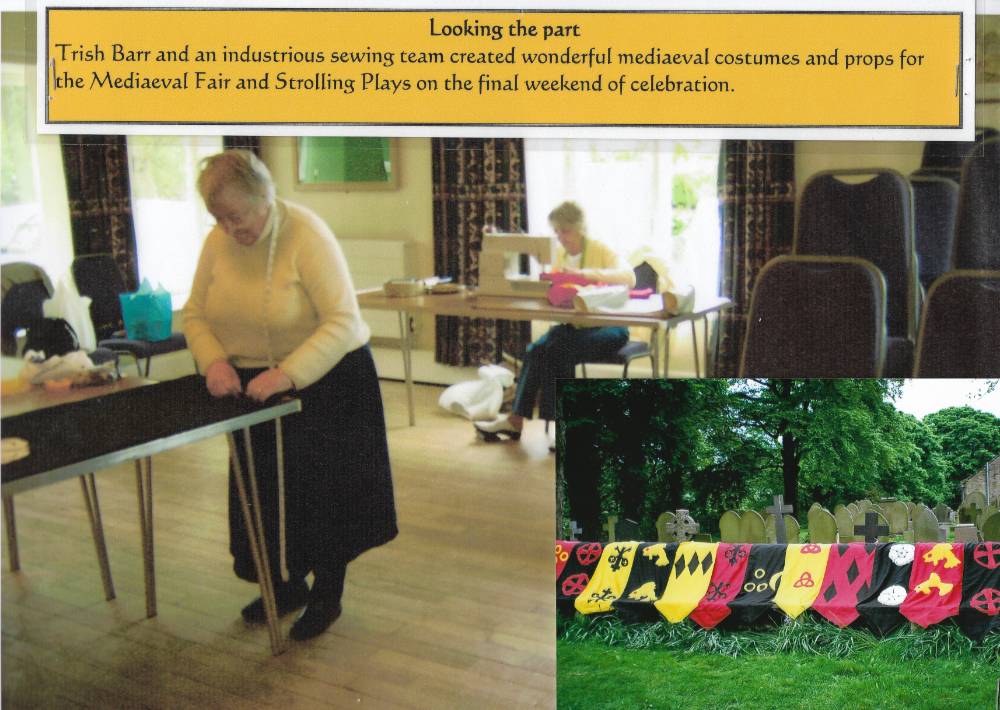
WULFHERE’S HARVEST : a play by Pat Laycock – how the Archbishop of York fled the Vikings and took refuge in Addingham – and what the villagers learned about God and themselves.
You can read here the sermon preached by Revd Andre Tawn on the subject of Wulfhere’s Harvest
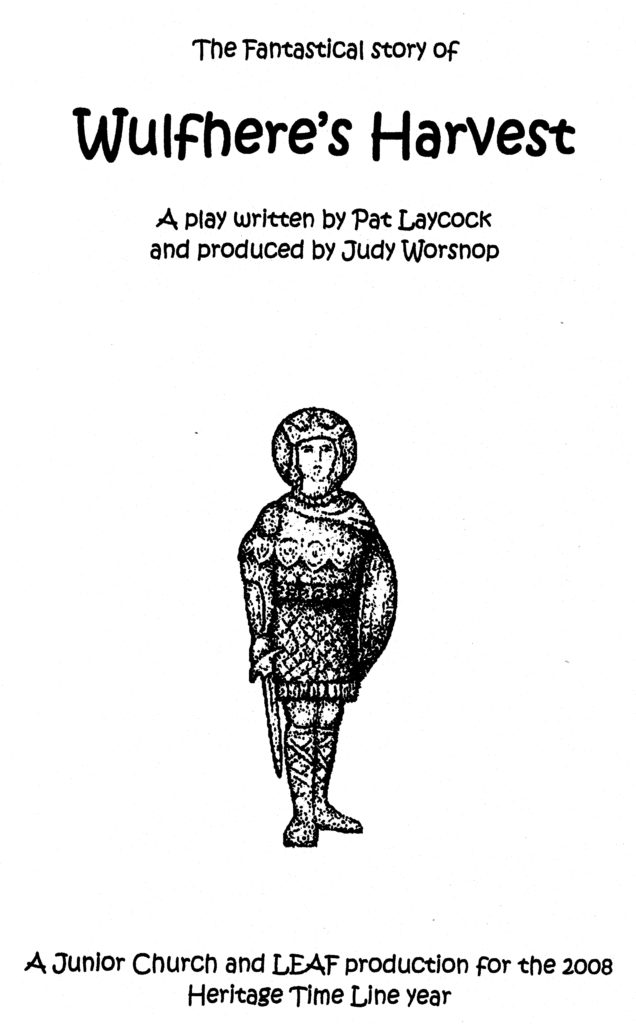
Sunday 14th September 2008 2.30 onwards STROLLING PLAY – written by Pat Laycock – depicting scenes from the 1400 year history of Addingham – see Weekend of Celebration.
Archaeology workshops
Archaeological work carried out at St Peter’s drew on expertise from the University of Bradford and the West Yorkshire Archaeological Trust. The excavation in front of the Church Hall took place in October 2007.
In May 2007, Arnold Pacey led a workshop for the Olicana History Society on the results of the roof timber dendrodating.
In April 2008, Arnold Pacey led a day-school on church architectural history. 32 people led by Arnold travelled by coach to local churches, to learn more about the historical features of St Peter’s church, particularly how it might have looked. There was a very interesting an informative tour of Adel church, Wragby church and the chapel of Hazlewood Castle. Arnold guided the party round each venue and shared his research and knowledge making the buildings come alive.
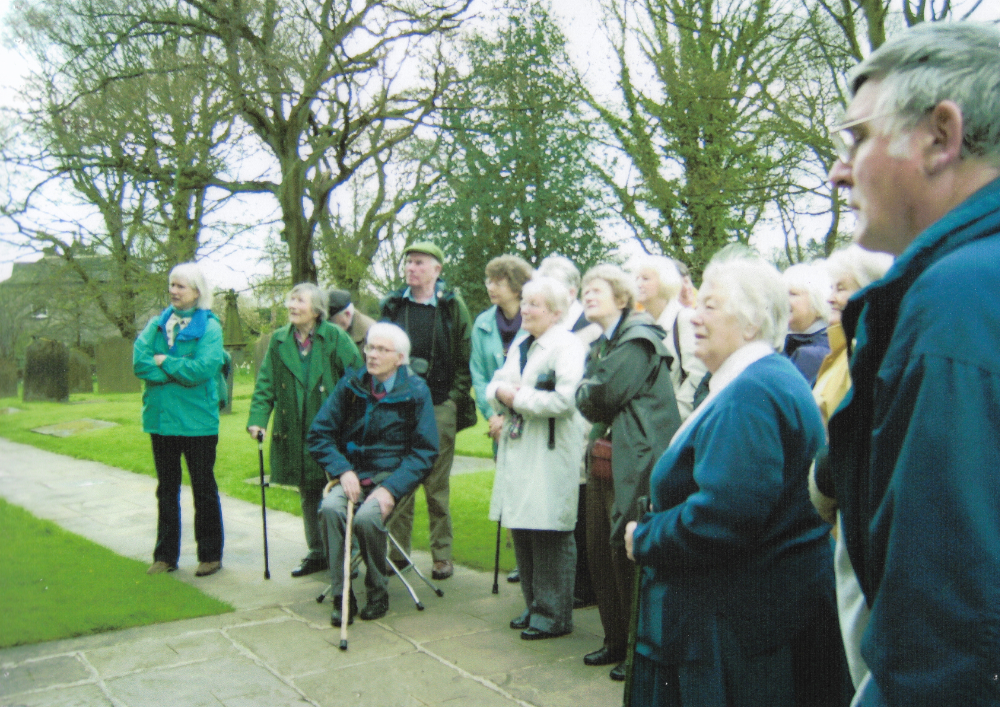
An enjoyable workshop introducing children to archaeological dig techniques was also held.

Saxon Food workshop
Led by Wendy Croft : to appreciate Saxon living conditions and prepare for the Saxon Feast :26 people met in St Peter’s Hall on Saturday 11th April for a Saxon Food demonstration. The assembled hungry diners thoroughly enjoyed learning about authentic ingredients and recipes from a different age before sitting down to partake of the delicious menu. Recipes included Vegetable Soup, Beef Casserole , Oat Bread, Onion Relish, Apple Butter, Lettuce Salad, Cabbage Salad, Cucumber Salad, Raspberry Sauce, Honey Mustard Sauce, Summer Fruits, Honey and Hazelnut Crumble, Sour Cream Custards
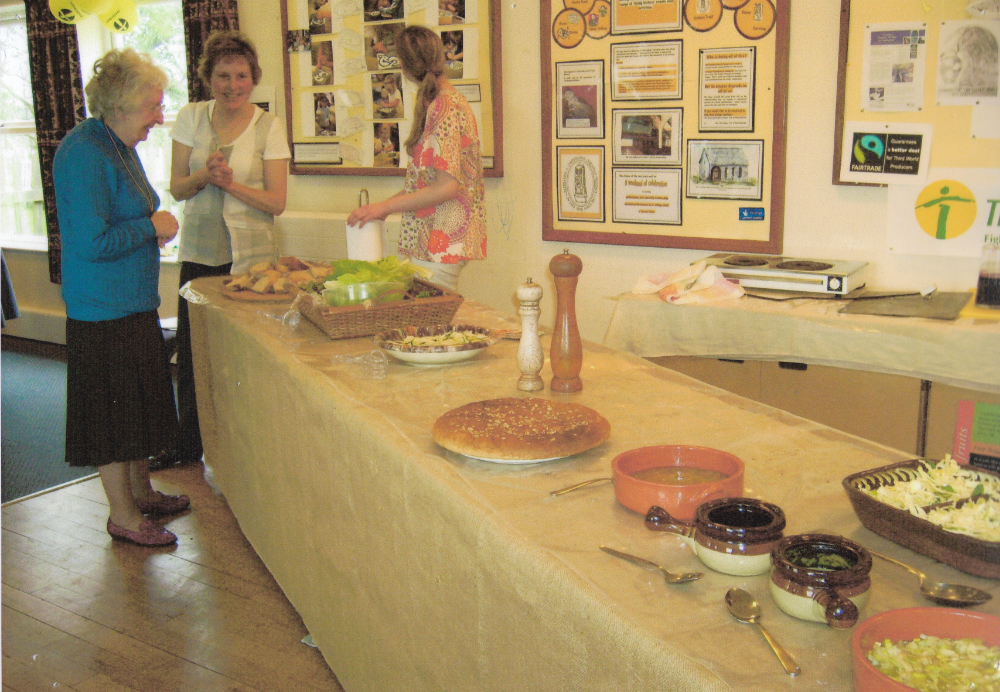
Music and words down the ages
A choral group was recruited from singers at St Peter’s and the Addingham Methodist Church to record an audio CD. The CD, of 10 minutes duration, contains a narrative commentary of the church’s history illustrated by a selection of music across the ages. New audio equipment was purchased and conected to the existing church sound system. This enables the CD to be played on demand by visitors, and can also now be heard via QR code.
A more comprehensive disc with additional music was recorded by the choral group at their request to celebrate their experience with the original CD. (This was a self financing development from the project)

Martin Ellis, a local sound engineer helped with both the recording and the equipment.
Historical information sharing the history of this unique site
Based on the latest findings from the archaeological dig and the dendro-dating, we have produced new information for visitors:
- a guide to the church in a readily accessible multilingual format
- backed up by our webpages so those who are further away or house-bound can keep in touch
- information boards, to be used by visitors such as walkers on the Dales Way which passes through our grounds. These explain the history of the site and village, pointing out visible features of interest, and linking these with other related local sites along the Dales Way, such as the Ilkley crosses, the Quaker Meeting House at Farfield and the Viking graves at Burnsall.
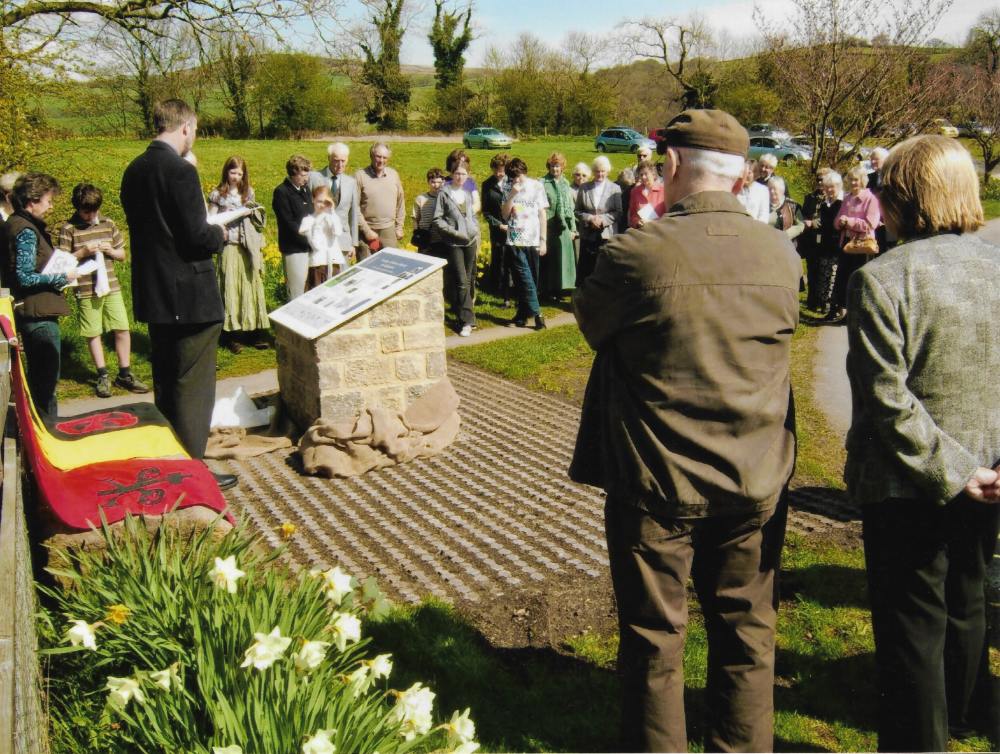
The boards were dedicated on Easter Sunday 2008
Historical themed Fete for all to enjoy
Our popular annual Fete on 21st June in 2008 had a Mediaeval theme as a light-hearted reflection of our project! Despite the terrible weather, a good time was had by all.
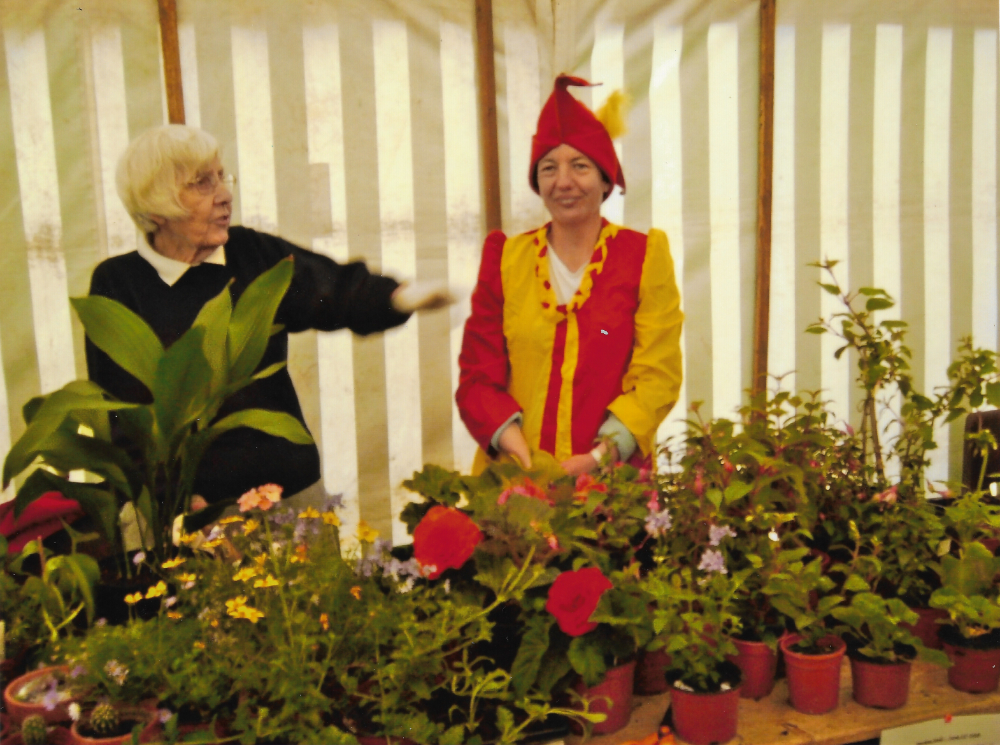
Weekend of celebration
Our project included a weekend of celebration, 13/14 September 2008
The whole village was involved in this celebration, deepening our knowledge and appreciation of the Saxon period in the development of our village life since that time.
On Saturday 13th September 11.00 am to 4.00 pm
Mediaeval fair – minstrels and merriment – a day long celebration of our village heritage, on Church Field – entrance and all activities was FREE – Story Telling, Falconry, Archery, Traditional Crafts demonstrations, Games and Activities for children of all ages, refreshments to buy from fine food stalls including Hog Roast.
On Sunday 14th September : a wonderful day of celebration, seriousness and happiness with the following elements:
8.00 am Holy Communion
12 noon Service of Celebration of the Christian timeline in Addingham led by Bishop of Bradford with Parish Communion
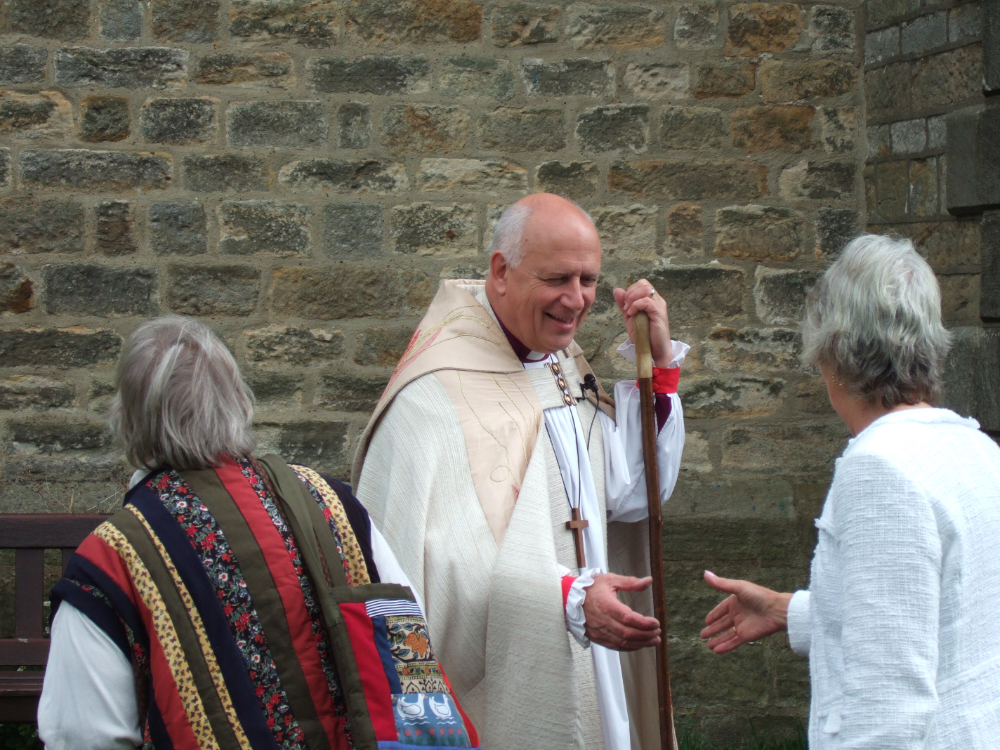
Service of Dedication for re-interment of bones of our Saxon ancestors excavated in the archaeological digs at St Peters.
Dedication of memorial panels for Saxon burials
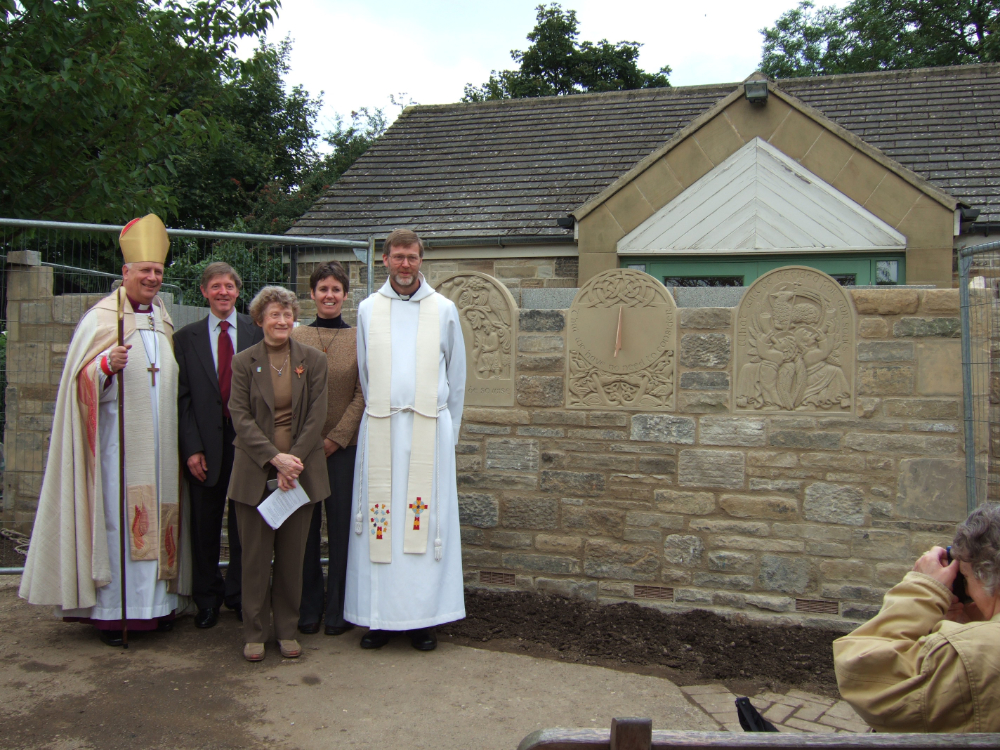
Also dedicated were the Christian timeline information and audio presentation in church which tell people of the history of the site and community.
Everyone welcomed to join in shared LUNCH in the Church Hall
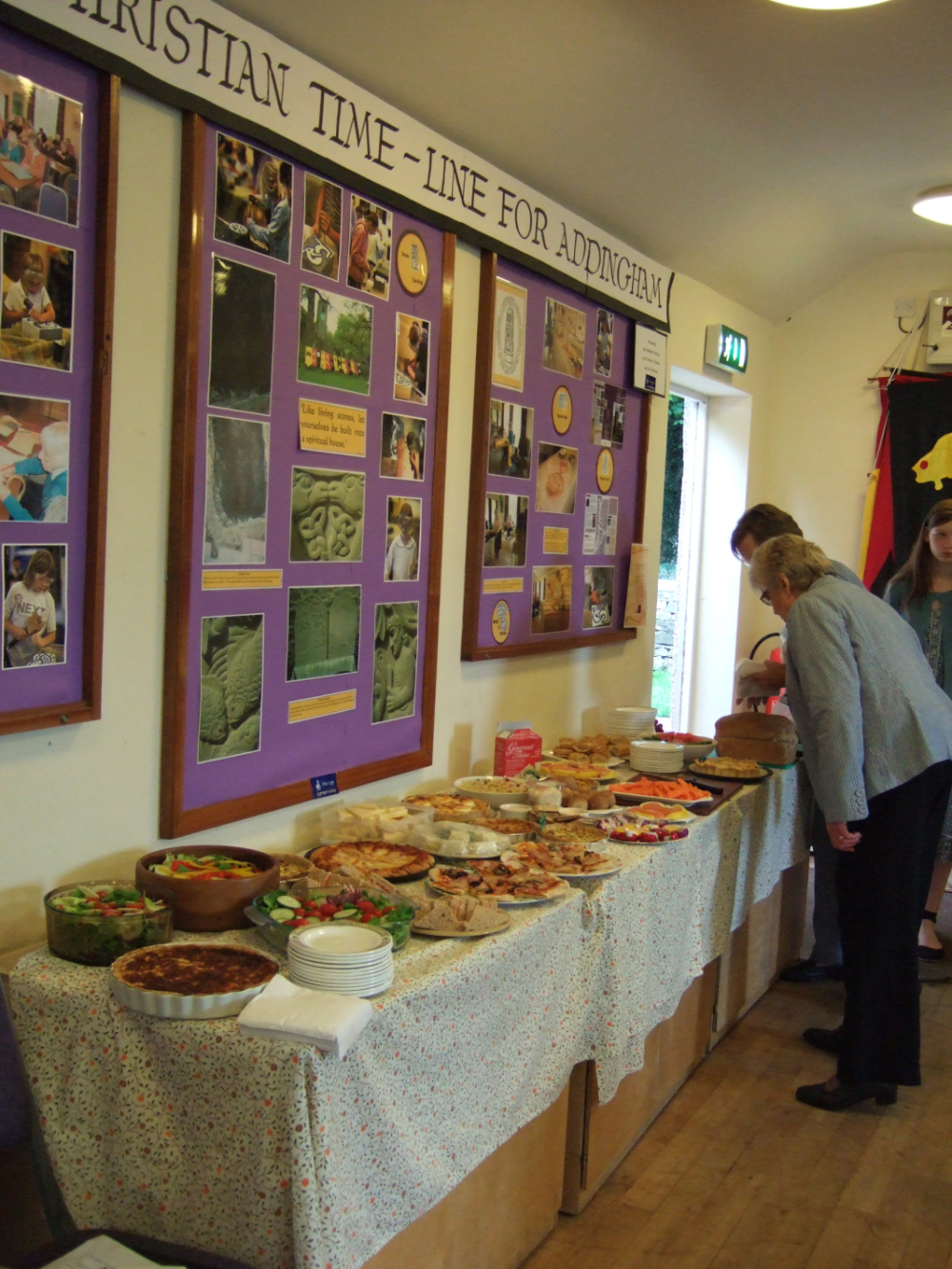
FOSPA served teas all afternoon
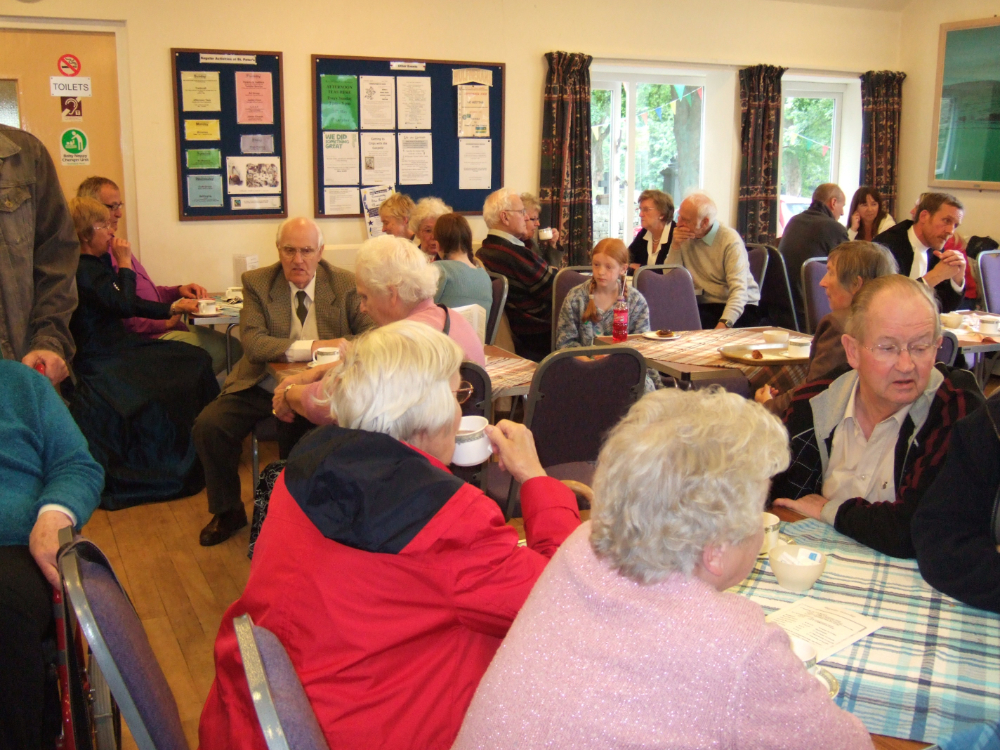
2.30 pm onwards STROLLING PLAY – depicting scenes from the 1400 year history of Addingham.
Ending with a service of celebration for the Christian TimeLine in Addingham
CELEBRATION PEAL : THE CHURCH BELLS RANG AGAIN THE FIRST PEAL THEY RANG WHEN NEWLY INSTALLED IN 1757
We look forward to seeing you at any time at St Peter’s!
Tapestry

This woven tapestry, The Earth is my Ancestors, is the work of the textile artist Meira Stockl.
It was given to the Church by six members of the congregation as a memorial to our Christian Saxon ancestors whose graves were discovered on the site of the extended hall building in 1990 and 1998.
DEDICATION TO AN UNKNOWN SISTER Eighth September 1998
What was your name ‘Female of about thirty years’
Where did you live?
How did you die
So young and with immaculate teeth?
Back across twelve hundred years
My mind reaches
For an understanding of your world,
Your Christian world,
At Hatyngham in Hwerverdale.
Standing on the edge of your resting place
I observe your skeletal resurrection.
What secrets will your bones reveal
Eighth century sister aged ‘about thirty years’?

